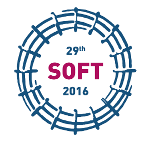Speaker
Hiroshi Tojo
(Japan Atomic Energy Agency)
Description
JT-60SA Thomson scattering system will measure electron temperature and density profile. A YAG laser will be toroidally injected to the JT-60SA on its equatorial plane. If the beam profile changes from flat-top to peaked profile, the laser beam breaks the vacuum window. Thus, we designed beam transfer optics as long as ~50 m using a relay image technique.
The beam transfer optics designed for the JT-60SA tokamak can transfer the image of initial beam profile (flat-top). The laser beam is transferred from the laser room to the last convex lens placed before the plasma and its size is suppressed within a preferable scale (30 mm). Fused silica, which does not have significant irradiation damage is planned to be employed as materials for the lenses and windows. The resultant beam width in the JT-60SA plasma can be minimized as less than 1 mm.
Coping with stray light is another important issue. When the laser goes through the vacuum window, diffuse reflection at the window generates stray light. The stray light can significantly affect signal-to-noise ratio because the Thomson scattered cross section is very small (7x10-29 -29 m22). Numerical ray tracing to simulate suitable number of baffle boards for JT-60SA suggested that more than four baffle boards are necessary to suppress the stray light. We adapted six baffle boards which reduces stray light by ~10% compared with the case without baffle boards.
Co-authors
Hiroshi Tojo
(Japan Atomic Energy Agency, Naka, Japan)
Kiyoshi Itami
(Japan Atomic Energy Agency, Naka, Japan)
Takaki Hatae
(Japan Atomic Energy Agency, Naka, Japan)
Takashi Hamano
(Japan Atomic Energy Agency, Naka, Japan)

